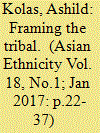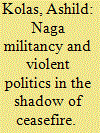|
|
|
Sort Order |
|
|
|
Items / Page
|
|
|
|
|
|
|
| Srl | Item |
| 1 |
ID:
079611


|
|
|
|
|
| Publication |
2007.
|
| Summary/Abstract |
A new great game is under way in Myanmar. The huge offshore gas findings stretching from the borders of Bangladesh down to Thailand have resulted in a flurry of diplomatic manoeuvring with China, Thailand and other ASEAN countries as well as United States, India, the European Union, Australia and Russia all playing key roles. The equations are bound to change and many countries, for fear of losing influence with Yangon, are seeking a more 'pragmatic' approach. As a result, the ruling regime, the State Peace and Development Council (SDPC), saturated with natural gas, finds itself at the centre of unexpected attention and unaccustomed wooing. Whether it be the Sino-Indian economic contests and resource competition in the Burmese gas sector or Thailand's increasing interest and growing influence in Myanmar, together this presents important leverage points for the SPDC, which has no doubt made it easier for the regime to withstand pressure for political reforms.
|
|
|
|
|
|
|
|
|
|
|
|
|
|
|
|
| 2 |
ID:
056448


|
|
|
|
|
| Publication |
Apr-Jun 2003.
|
|
|
|
|
|
|
|
|
|
|
|
|
|
|
|
| 3 |
ID:
151470


|
|
|
|
|
| Summary/Abstract |
This article examines the framing of ‘ethnic conflict’ in Northeast India, focusing on militant groups and insurgency in the hill areas of Assam and a form of political violence known locally as ‘ethnic clashes’. The article argues that ‘ethnic clashes’ have become an institutionalized form of armed violence in the region, while ‘ethnic rivalry’ is a key diagnostic frame for conflict. As enactments and imaginaries of institutionalized violence, ‘ethnic clashes’ are a product of actors who hold stakes in representing armed political violence as a result of ‘ethnic conflict’ between rivaling tribal communities. The article looks at the representation of causes of conflict as well as the framing of acts of violence as key sites of contestation, and thus as integral aspects of the conflict. This raises questions about the feasibility of scholarly efforts to make sense of specific cases of conflict via generic categories such as the ‘ethnic conflict’.
|
|
|
|
|
|
|
|
|
|
|
|
|
|
|
|
| 4 |
ID:
109195


|
|
|
|
|
| Publication |
2011.
|
| Summary/Abstract |
Ceasefires are often seen as a simple measure to end violence and allow more substantive negotiations to begin. Contemporary conflict resolution models thus posit the ceasefire as a basic step in the peacebuilding trajectory. Offering an in-depth analysis of Naga militancy in Northeast India, this article argues that ceasefires should rather be understood as a part of the dynamics of conflict. Northeast India is a site of protracted conflict involving multiple contestants, where Naga militant organizations play a key role. A string of ceasefires since 1997 between the Indian government and the National Socialist Council of Nagalim (NSCN) has contained fighting between security forces and militants, while violence has continued unabated between NSCN factions and among an array of other armed groups in the area claimed as 'Nagalim', with serious consequences for local communities. This study suggests that ceasefires may impact on conflict dynamics in at least three ways, all interrelated: (1) by affecting the internal cohesion of belligerent groups, (2) by affecting the operational space of armed groups, and (3) by affecting the relations between multiple stakeholders and parties to a conflict, including but not limited to the challenger(s) and the state. The study concludes that the terms of ceasefire agreements, the strategic use of ceasefires by conflict actors, and the opportunities created by a lack of effective monitoring of ceasefire ground rules has facilitated the operations of militants vying for territory, revenues from illegal 'taxation' and political stakes. Ceasefires have also paved the way for an escalation of factional and intergroup fighting and violent politics in Northeast India, by empowering signatory groups versus contenders as well as nonviolent actors.
|
|
|
|
|
|
|
|
|
|
|
|
|
|
|
|
| 5 |
ID:
079782


|
|
|
|
|
| Publication |
London, Routledge, 2008.
|
| Description |
xii, 154p.
|
| Standard Number |
978041543436
|
|
|
|
|
|
|
|
|
|
|
|
Copies: C:1/I:0,R:0,Q:0
Circulation
| Accession# | Call# | Current Location | Status | Policy | Location |
| 052783 | 338.4791515/KOL 052783 | Main | On Shelf | General | |
|
|
|
|
|
|
|
|
|